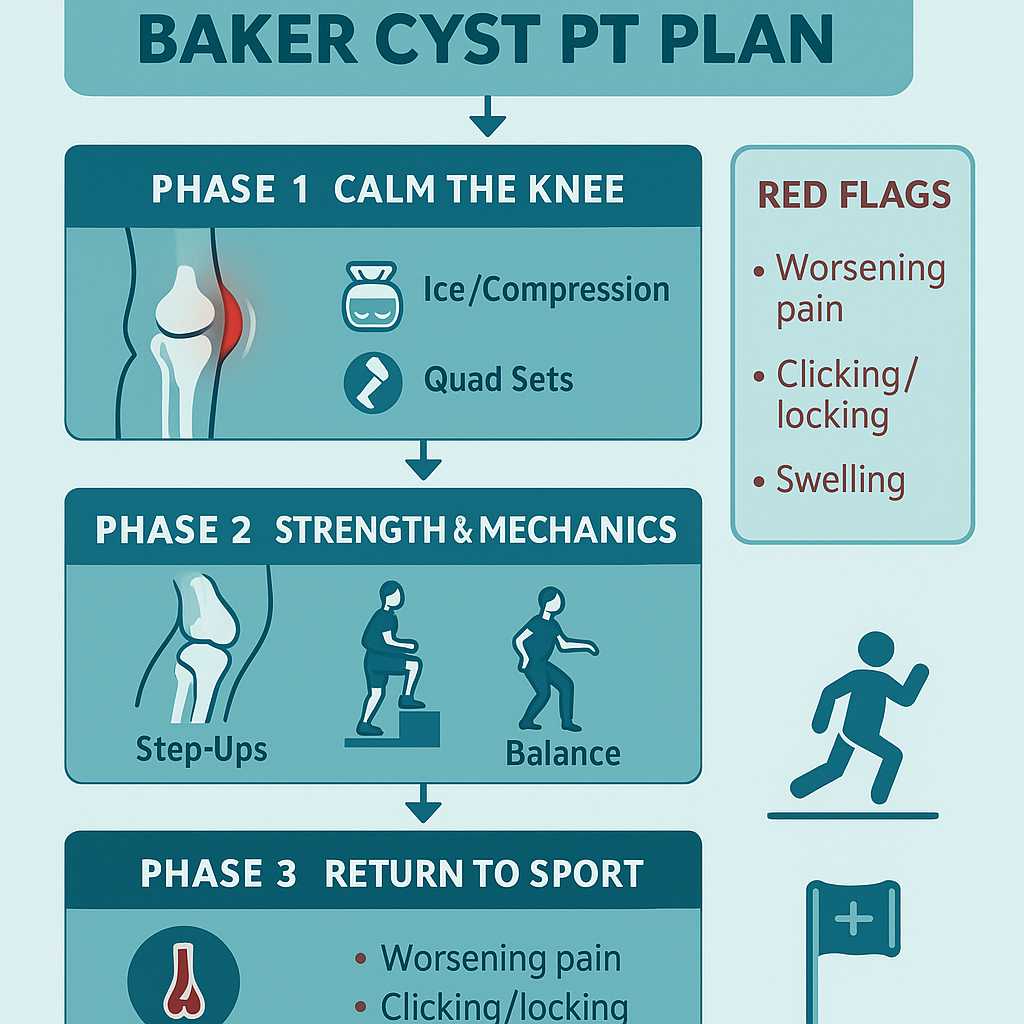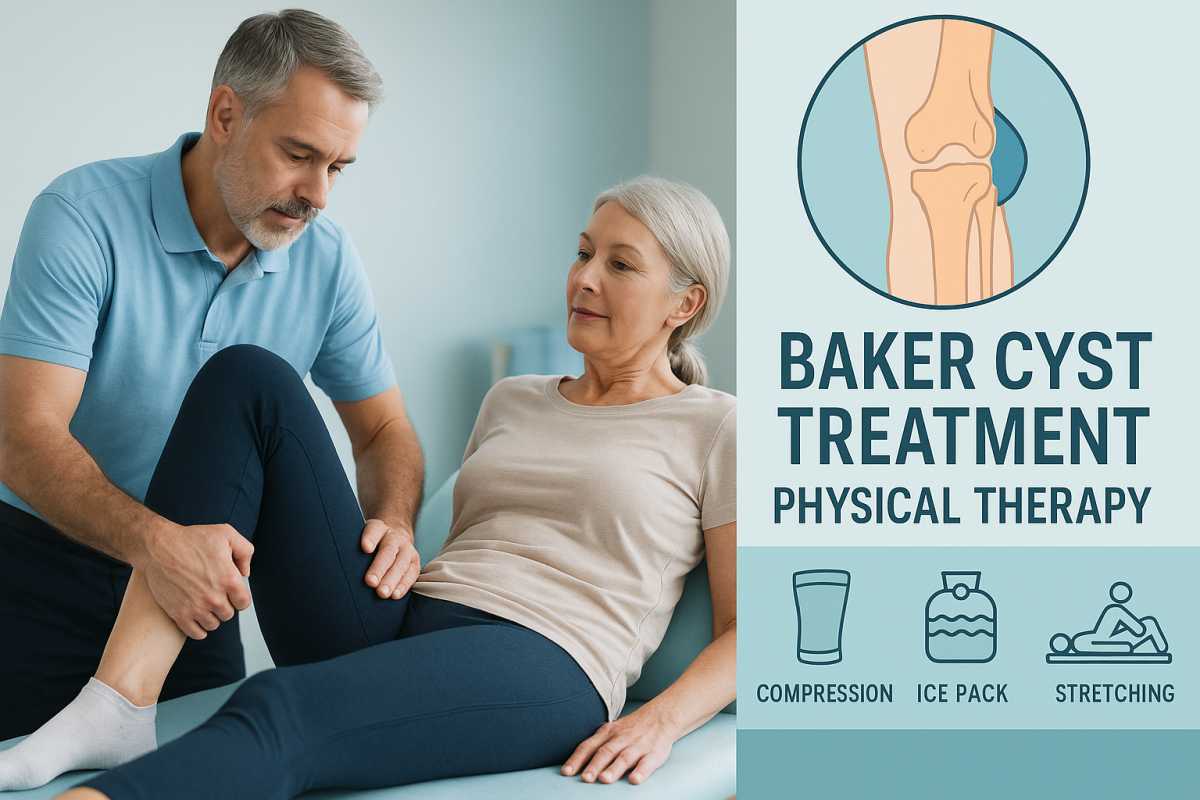A Baker’s cyst—also called a popliteal cyst—is a fluid-filled swelling behind the knee. It’s usually not the “main problem,” but a sign that the knee is irritated inside (think meniscus wear, osteoarthritis flare, or synovitis). When the joint makes excess synovial fluid, it can bulge into the back of the knee and form that familiar tight, sometimes painful lump.
Symptoms range from a mild fullness with bending to a stiff, pressure-like ache when you try to squat, climb stairs, or run. Some people also feel sharp pulling with terminal knee extension (straightening the leg fully).
Where Physical Therapy Fits
Baker Cyst Treatment Physical Therapy focuses on two goals:
calm the irritated knee so the joint stops over-producing fluid, and
restore mechanics so you can bend, load, and move without the cyst refilling.
In most cases, consistent PT can reduce symptoms, improve function, and help you avoid procedures. If you do need aspiration or an injection, PT still matters—it addresses the why behind the fluid so the cyst is less likely to return.
Your First PT Visit: What We Check
A thorough evaluation typically includes:
History & irritability: what activities flare it, morning stiffness, catching/locking.
Range of motion: loss of terminal extension is common and needs attention.
Swelling & tissue tone: behind-the-knee fullness, calf tightness, hamstring guarding.
Movement quality: gait, squat pattern, single-leg control, hip strategy.
Load tests: step-downs, sit-to-stand, or gentle hopping (as tolerated) to map limits.
Red flags we screen for: sudden severe calf pain/swelling (rule out DVT), true joint locking, fever or redness (infection concerns), and traumatic injuries suggestive of a significant meniscus or ligament tear. Those need medical workup before heavy rehab.
Exercise Plan for Baker’s Cyst
Phase 1 — Settle the knee (1–2 weeks)
Goals: reduce pain/pressure, restore gentle motion, keep you moving safely.
Tools: relative rest (skip deep squats/sprints), ice or contrast, compression sleeve, and heel-to-toe walking with shorter stride.
Manual therapy: patellofemoral and tibiofemoral mobilizations (as tolerated), soft-tissue work for the calf/hamstrings to ease posterior tension.
Mobility:
Heel slides × 10–15, 2–3 sets
Prone hangs or towel prop for terminal extension (gentle, 60–120 sec)
Calf stretch against wall (knee straight & bent), 30–45 sec × 2–3
Activation:
Quad sets (5-sec hold) × 10–15
Straight-leg raise × 10–12
Short-arc quads with a towel roll × 12–15
Phase 2 — Strength + mechanics (2–6 weeks)
Goals: normalize gait, build tissue capacity, stop the “refill” pattern.
Strength (2–3 days/week):
Sit-to-stand (box height you can control) 3×8–10
Step-ups (low box) 3×8 each side
Hip hinge/RDL (light DB or band) 3×8–10
Side-lying hip abduction or banded walks 3×10–12
Neuromuscular control:Single-leg balance (eyes open → head turns → eyes closed) 3×20–30 sec
Mini-squats with band around knees (track the knee, avoid valgus) 2–3×10
Mobility maintenance: keep the calf/hamstring/quad flexibility work; add gentle posterior chain glides.
Phase 3 — Return to impact & sport (4–10+ weeks)
Goals: tolerate stairs, hills, jogs, and change of direction without swelling spikes.
Progressions:
Step-downs (control knee over 2nd toe) 3×8
Split squats or reverse lunges 3×6–8 each side
Low-amplitude hops or pogo jumps (if impact is your goal) 3×10
Conditioning: bike/elliptical → jog intervals → continuous run (no >2/10 swelling next day).
Rule of thumb: if the back-of-knee pressure jumps and lingers 24–48 hours after an activity, dial back 10–20% and rebuild gradually.
Helpful Adjuncts
Taping/Bracing: a light compression sleeve or kinesio taping may reduce perceived fullness during activity.
Footwear/orthotics: if your mechanics collapse inward, supportive shoes or a light orthotic can offload the knee.
Weight/load management: even small changes in weekly mileage or downhill volume can be the difference between calm vs. cranky.
When Procedures Enter the Picture
If a cyst is very large, tense, or repeatedly refills despite good PT, your clinician may coordinate with a physician for:
Aspiration (draining fluid) and/or
Corticosteroid injection to quiet synovitis.
These can provide relief, but they work best alongside PT that corrects mechanics. Surgery is uncommon and typically reserved for structural lesions that keep re-irritating the joint.
At-Home Mini Exercise Program (Sample Week)
Daily: quad sets (2×15), calf stretches (2×30–45s each), heel slides (2×10)
3×/week: sit-to-stand 3×10, step-ups 3×8/side, banded walks 3×12
Balance: single-leg stand 3×30s (progress eyes/terrain)
Cardio: 20–30 min brisk walk or bike (low resistance), monitor swelling next day

Keep a simple log: pain (0–10), swelling, and activities. If numbers creep up three days in a row, you probably progressed too quickly—ease off, then rebuild.
Related Article: Sports Massage at Home
NYC Notes: Finding the Right Clinic
In New York, look for centers that:
Offer one-on-one PT sessions (not crowded gyms),
Perform a full gait/squat analysis,
Blend manual therapy + progressive loading,
Provide a clear home program with video demos,
Coordinate with imaging/orthopedics if red flags appear.
A quick call can tell you a lot—ask how they handle Baker’s cysts and whether they teach self-management between visits.
Bottom line
Baker Cyst Treatment Physical Therapy isn’t about chasing the cyst; it’s about calming the knee and fixing the way you load it, so fluid production settles down. With phased mobility, targeted strength, and smart activity progressions, most people can bend, climb, and even run without that persistent back-of-knee pressure calling the shots. If you need a procedure, PT remains the glue that keeps results lasting.
